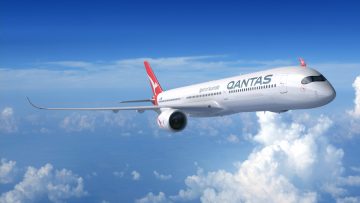
Qantas will mark the end of an era with the departure of one of its Boeing 717 jets, the first of its type to be registered and flown in Australia.
The departing 717 (registration VH-NXI) holds a special place in the Qantas Group’s modern history, having operated Jetstar’s first flight between Melbourne and Launceston on the day the airline started flying in May 2004.
The aircraft has also flown on regional and domestic routes for QantasLink for the past 15 years.
All up, it has completed more than 29,000 flights and safely carried more than 1.6 million customers for both Qantas and Jetstar over two decades.
Named Blue Mountains after the world-heritage listed national park in New South Wales, the aircraft is due to depart Australia in mid-June ahead of being sold to another major carrier. It is the third of the airline’s 717s to leave the fleet and its range limits mean the journey to its new owner in North America will involve eight fuel stops, including Cebu, Sapporo and Anchorage.
All of QantasLink’s 20 Boeing 717s will be gradually replaced by 29 fuel efficient Airbus A220 aircraft as part of the “Project Winton” fleet renewal programme.
The first A220 aircraft is due to arrive later this year and the first of 20 A321XLRs will arrive in late 2024.
The departing 717 was flanked at Sydney Airport this week by two new arrivals in the fleet – a Boeing 787-9 Dreamliner and a Jetstar Airbus A321 neo long-range (LR) aircraft.
The next generation models are part of a significant investment in fleet renewal that will see the Qantas Group take delivery of a new aircraft every three weeks on average for the next few years.
The incoming aircraft will help Qantas and Jetstar restore capacity and expand their network while lowering emissions and improving efficiency.
Qantas’ latest Boeing 787 Dreamliner, Billabong, started flying on the airline’s international network this month, with another two Dreamliners to be delivered over the next three weeks.
These additional aircraft enabled the resumption of Sydney-San Francisco flights and will support the launch of the Sydney to New York via Auckland route next month. This will bring Qantas’ 787-9 fleet to 14.
Jetstar also this month welcomed its seventh Airbus A321 neo LR aircraft, which are 50 per cent quieter than the older A321s they replace and burn up to 20 per cent less fuel. They are operating domestic services and flying between Australia and Bali. The airline will receive another 11 A321neo LR aircraft by the end of 2024.
Through a combination of new arrivals and standby aircraft returning to service, the Qantas Group has returned to around 100 per cent of pre-COVID domestic flying levels and expects to restore 100 per cent of international flying by March 2024.
Qantas Group CEO Alan Joyce commented: “Qantas is in the early stages of the biggest fleet renewal program in its history, with up to 299 narrowbody aircraft spread over 10-plus years as well as the A350s that will operate our Project Sunrise flights. It’s an incredibly exciting time for our employees as well as our customers as these new aircraft create more opportunities and unlock new destinations.
“We’ve already taken delivery of four new aircraft this year and we’re on track to receive another eight before the end of the year.
“The new aircraft we’re receiving are much more capable than the aircraft they’re replacing. They can fly further while being much quieter and more efficient and providing a great experience for our passengers.”











